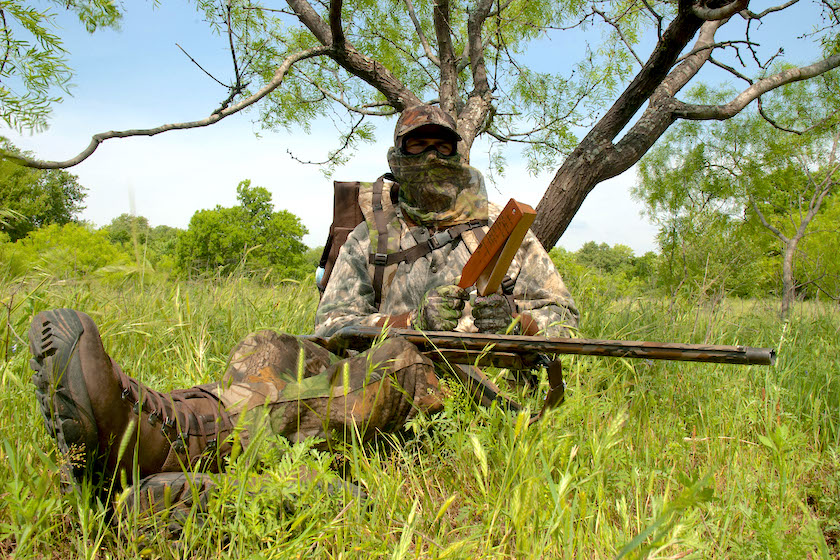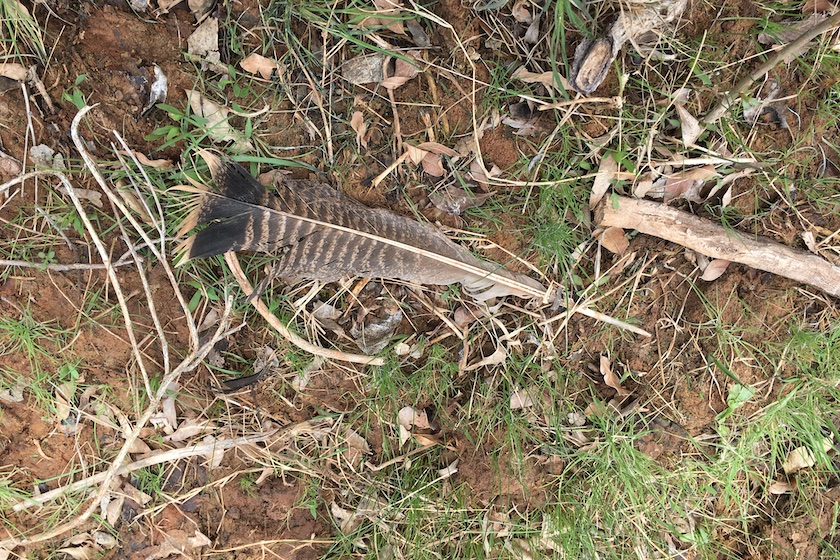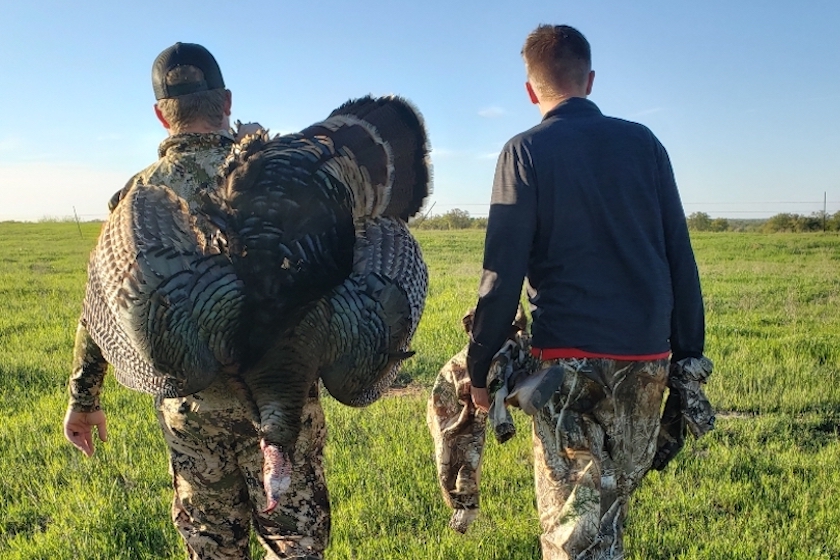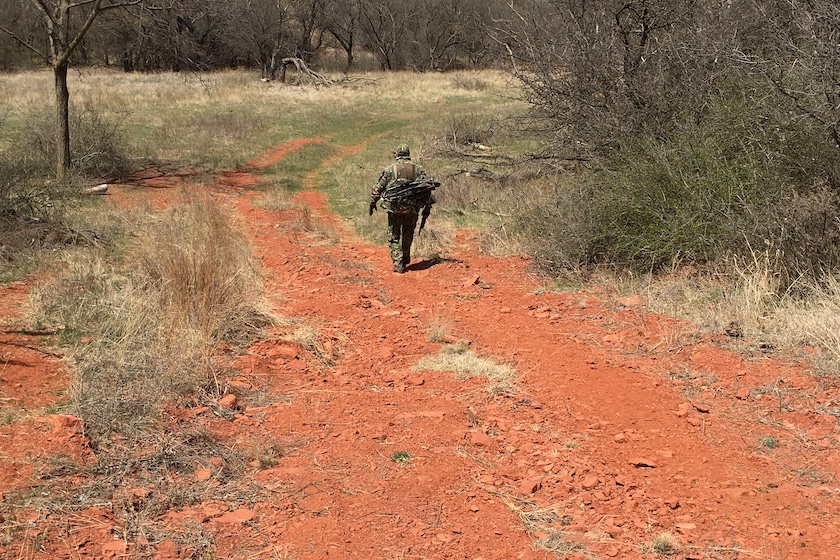
How to hunt spring turkeys when the wind blows and blows and blows. (Photo by Lynn Burkhead)
- Click here for more articles on turkey hunting from Game & Fish
To be honest, it was the kind of day that I’d just as soon stayed at home and taken an overdue nap, even if the calendar was quickly running out of days to spring turkey hunt.
But instead, I dutifully got up and dressed in my camo duds, heading for the door and an afternoon turkey hunt with my longtime hunting pal Doug Rodgers as we headed west to his North Texas turkey lease.
I’ll admit, I wasn’t optimistic. In fact, if it weren’t for the prospect of some late-evening enchiladas at a nearby Tex-Mex place, I might not have even gone. Why? The wind, that’s why.
If you’ve ever hunted anywhere near the Great Plains, you know exactly what I’m talking about, heading out for a hunt when the wind blows and blows and blows.
Turning the weatherman’s anemometer at 25 miles per hour—or more—the southerly gale promised to pump up the atmosphere with unstable Gulf of Mexico moisture and make hearing a gobbler all but impossible.
Add in atmospheric instability from an approaching late-spring cold front, and the day was ripe for severe thunderstorms, hail stones, and tornadoes.
But not heavily bearded and long-spurred Rio Grande gobblers.
Stout wind or not, and tornado weather or not, Rodgers was determined to put yours truly on a good-sized gobbler that afternoon to help end a long drought on my turkey hunting scorecard.
Like a card shark with a couple of aces up his sleeve, the Whitesboro, Texas, resident had a good idea of when and where the birds might be moving about on that howling April afternoon.

Armed with a custom-built Lamar Williams boat paddle box call, Rodgers kept working that wild turkey music maker to noisy perfection, eventually striking up a couple of longbeard toms that could hear our loud calling even if we could barely hear their gobbling responses.
In fact, at one point, the biggest tom of the pair actually seemed to come off his feet as he gobbled aggressively in response to Rodger’s calling on the box call. But a gust of wind tore the music away from our ears and we couldn’t hear a syllable of the old boy’s response even if our eyes told us otherwise.

Less than a half-hour later, our game of wild-and-windy chess was over as I tagged the Rio Grande bird and Rodgers was putting another mental mark on his paddle call, the kind of wind-defeating instrument that Williams, a Starke, Fla., resident trained by the late great turkey call maker Neil Cost, specializes in turning out each year.
In fact, I’ve never been on a spring turkey hunt before or since with Rodgers where that butternut-and-cedar musical instrument wasn’t tucked away carefully in his turkey-hunting vest.
Truth be told, even if you hunt somewhere else outside of Texas, big winds are a common enemy of turkey hunters everywhere each spring, something that hunters all across the country have to battle in order to tag a longbeard.
One such hunter is Matt Morrett, friend of country music superstar Blake Shelton and a well-known hunting celebrity himself in TV shows, Facebook videos, and YouTube content put out by companies like Hunter Specialties, Avian-X Decoys and Zink Turkey Calls, among others, companies he formerly worked for.
A former world champion turkey caller, nowadays Morrett is the marketing director for the Pennsylvania Game Commission. In addition to promoting the outdoors in his home state every day, he still finds plenty of time to get out and chase longbeards.
With lots of Keystone State experience, as well as travels all across the country, Morrett—always one of my favorite interviews when it comes to turkey hunting—has seen the best and worst that the springtime chase of longbeards has to offer. And more than once, he’s felt the curse of the springtime wind as it blows across his neck.

“I’ve (been) to Alabama before where you get a cold front through and they just shut down,” said Morrett in an interview we had a couple of years ago. “I mean their mouths are shut. I think wind is the toughest thing about hunting any wild animal.”
But windy day or not, the annual spring game isn’t put on hold, at least from a wild turkey’s point of view.
“It’s not that they’re not trying to find hens, not that they’re not gobbling, not that they’re not trying to breed,” said Morrett. “But there’s so many things that go against you (as a turkey hunter) when it’s windy.”
“That’s because a turkey can’t see as well and he’s definitely jittery because he can’t hear as well.”
So how does a turkey hunter combat windy day gobblers in Texas, Alabama, or somewhere else?

Table of Contents
1. Make Loud Calls
First, by being armed with a loud call that can cut through the building gale, one like the Lamar Williams boat paddle box call mentioned above or something like a Zink Turkey Calls Wicked Series crystal call.
The latter, a pot style friction call made of Brazilian cherry wood, utilizes the injection of acrylic into the wood and a crystal surface that offers top end high-pitch raspy calls that are loud and reach out to gobblers at a longer range than many other calls do.
2. Find the Sign
A second key to tagging a mature longbeard when the wind is howling is to do what Rodgers and I did years ago, and that’s to put yourself into areas where turkeys are known to roost, travel, feed, and breed. If the area is lousy with sign ranging from loose feathers to tracks to droppings to scratches in the dirt where gobbler wings have been dragging as big toms strut about, a good tip is to park your fanny there and wait.
Because no matter what the spring conditions are — from a snowstorm like the one that assaulted midwestern turkey grounds this week to triple-digit heat that is only days away in Texas, from drought to thunderstorms, from dead calm conditions to a hurricane-like gale — turkeys are going to continue to do what turkeys do each spring.
“Hens are going to go to the gobblers, they’re going to try to find food and they are going to try to find water,” said Morrett.
3. Use the Wind
A third tactic is to use the wind and put it in your favor while hunting. Eddie Salter, former host of Turkey Man on the Sportsman Channel and a turkey calling champion of great renown, follows a similar strategy when battling windy day gobblers, especially after the passage of a spring cold front.
That strategy centers around loud, aggressive calling and moving into the wind so that the sounds that a wild turkey gobbler makes will travel to the hunter’s ears and not be torn away from them.
4. Use the Terrain
A fourth strategy is to use the terrain to your advantage, seeking to use the wild turf in an effort to help keep the wind’s ill effects a bit tamer. While this isn’t easy in plains territory, it can be more effective in wooded areas, creek bottoms, and hilly terrain where the lay of the land can actually help you hear what’s going on a little better.
“What I try to do is get into an area where I know the birds are at and keep moving,” said Salter. “And if I can, (in hilly terrain) I try to stay down below them. That way, if I can get a bird to gobble, chances are that I may hear him.”
5. Just Go Hunting
And finally, a fifth strategy to employ is to simply get up and go hunting like I did earlier in this wild-turkey tale, even if it’s going to be a windy day. Because the bottom line is that hearing a gobbler on a blustery day means that the battle is already half won. For when the wind blows hard, any gobbler that is close enough to be heard is not very far away.
Armed with a good call and with any sort of springtime luck, the next sound that a hunter hears in the turkey woods might not be a lusty gobble, but it could be the sound of a very loud shotgun going Boom!
Even if that sound is quickly drowned out by the noise of the springtime wind as it blows and blows and blows. But you won’t mind at all as you smile and reach for the turkey tag about to be pulled from your back pocket.










































